Houseplants possess the wonderful ability to purify indoor air, promoting a serene atmosphere and reducing stress levels. However, while many of us enjoy having plants in the home, we may not always have a lot of time or skill to care for them. Fortunately, there are tons of houseplants available that are not only visually stunning but also require minimal maintenance.
When choosing a houseplant that looks amazing and requires very little care, it is crucial to consider your personal needs and preferences. Take into account the amount of available light, the time you can dedicate to care, and the aesthetic you desire. With a bit of research, you will undeniably discover the perfect houseplant that complements both you and your home. We’ve compiled a list of several amazing and easy-to-care-for houseplants, so you can get growing!
Choosing the Right Houseplants
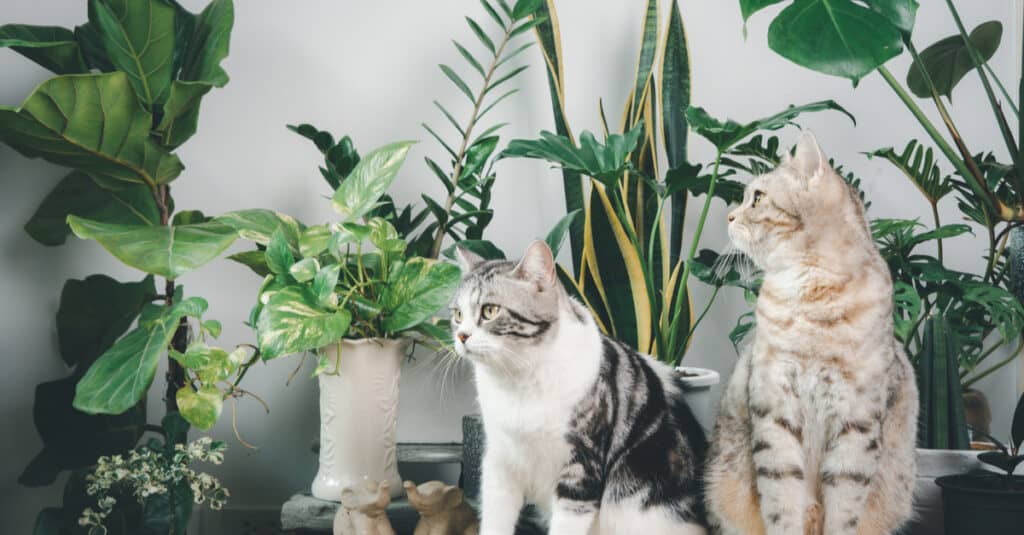
One strategy for keeping your pets safe is to move toxic plants to an isolated shelf or room that’s inaccessible to your cat.
©Foto2rich/Shutterstock.com
Just like people, plants have different preferences that help them maintain their amazing appearances. Some thrive in bright, direct light while others prefer indirect light. Similarly, while certain plants require frequent watering, others can survive for weeks without it. Here are some questions to consider:
Can I Provide the Right Kind of Light?
Different species of plants have varying lighting needs depending on their natural habitats. For instance, many succulents, known for their water-storing properties, thrive in full sunlight. On the other hand, ferns, which typically grow beneath the forest canopy, prefer indirect light to mimic their natural environment. If you’re unsure about the specific lighting requirements of your plant, start with less light initially, and gradually increase it. By carefully observing your plant’s response, you can ensure that it receives the optimal amount of light necessary for its health and growth.
Can I Water It Correctly?
The watering needs of each plant are based on several factors, including the type of plant, the size of the pot, and the climate conditions. As a general guideline, water your plants when the top inch of soil becomes dry to the touch. Avoid excessive watering, as this can lead to root rot and potentially harm the plant’s health. Remember to observe your plants closely, be mindful of their specific needs, and adapt your watering routine accordingly.
Should I Be Fertilizing My Plants Regularly?
Providing the proper nourishment for each plant is vital if you want it to produce vibrant and thriving foliage. This can be achieved by selecting the appropriate fertilizer tailored to their specific needs. For optimal results, carefully follow the instructions provided on the fertilizer label.
What Are Repotting Requirements?
As your plants grow, you will need to transfer them into larger pots to accommodate their expanding roots. This ensures that they have ample space to grow and flourish, promoting steady growth and vitality. When repotting, carefully choose a container that is only one size bigger than their current pot. This gentle transition allows the plants to seamlessly adjust to their new environment.
How Can I Keep Plants Pest and Insect-Free?
Regularly check your plants for common pests such as spider mites, mealybugs, and aphids. These pesky critters can wreak havoc on your plants if left unchecked. If you discover any unwelcome visitors, promptly address the issue. Treat them with either insecticidal soap, which suffocates the pests, or neem oil, which acts as a natural deterrent.
Now, let’s take a closer look at some of the easy-to-care-for, beautiful houseplants out there!
Houseplants That Look Amazing and Require Very Little Care: Pothos
Also known as devil’s ivy, pothos is a versatile plant that thrives in a variety of conditions. It tolerates low light, infrequent watering, and even neglect. Pothos is a fast grower, ideal for quickly adding green to your home. Originating from Southeast Asia, these elegant vines can gracefully extend up to 10 feet. With heart-shaped leaves in shades of green, yellow, or variegated patterns, pothos plants adorn hanging baskets and effortlessly climb trellises or walls. They thrive in bright, indirect sunlight but adapt well to lower light conditions. Pothos plants are resilient to pests and diseases, making them popular among plant enthusiasts. The following are some of the more common pothos houseplants.
1. Golden Pothos
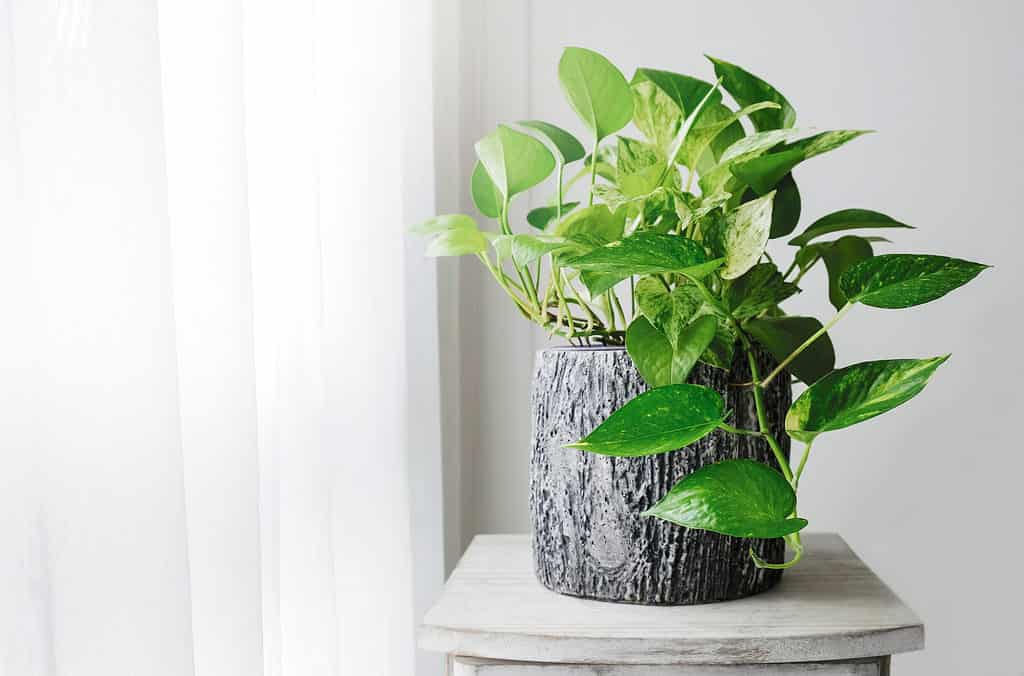
Although generally resistant to pests and diseases, spider mites and mealybugs can pose a threat to golden pothos plants.
©ArtBackground/Shutterstock.com
Golden pothos (Epipremnum aureum), also known as devil’s ivy or money plant, is a popular houseplant due tp its low-maintenance nature and striking heart-shaped, variegated leaves. The versatility of golden pothos makes it ideal for beginners and those with limited space, easily adaptable to both hanging baskets and pots. It thrives in a wide array of conditions, preferring bright, indirect sunlight but capable of surviving in low-light settings. Regular misting helps to enhance humidity, and you’ll want to repot your golden pothos every two to three years in a larger container to help it flourish.
2. Marble Queen Pothos
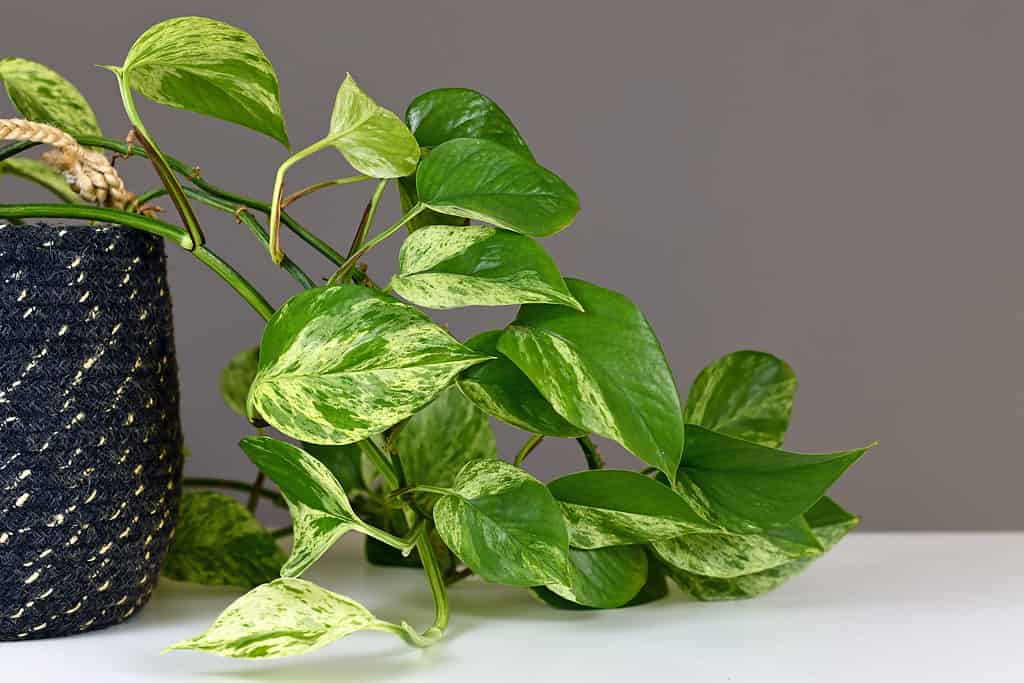
Marble queen pothos is perfect for beginners, apartments, or small spaces, and grows well in hanging baskets or pots
©iStock.com/Firn
The marble queen pothos (Epipremnum aureum ‘Marble Queen’) is known for its stunning variegated foliage. Its heart-shaped leaves feature intricate patterns in white or cream, adding elegance to any indoor space. This resilient and low-maintenance plant thrives in bright, indirect sunlight but can also adapt to low-light conditions. However, avoid direct sunlight to prevent leaf scorching. It’s relatively resistant to pests and diseases, but watch out for spider mites and mealybugs.
3. Pearls and Jade Pothos
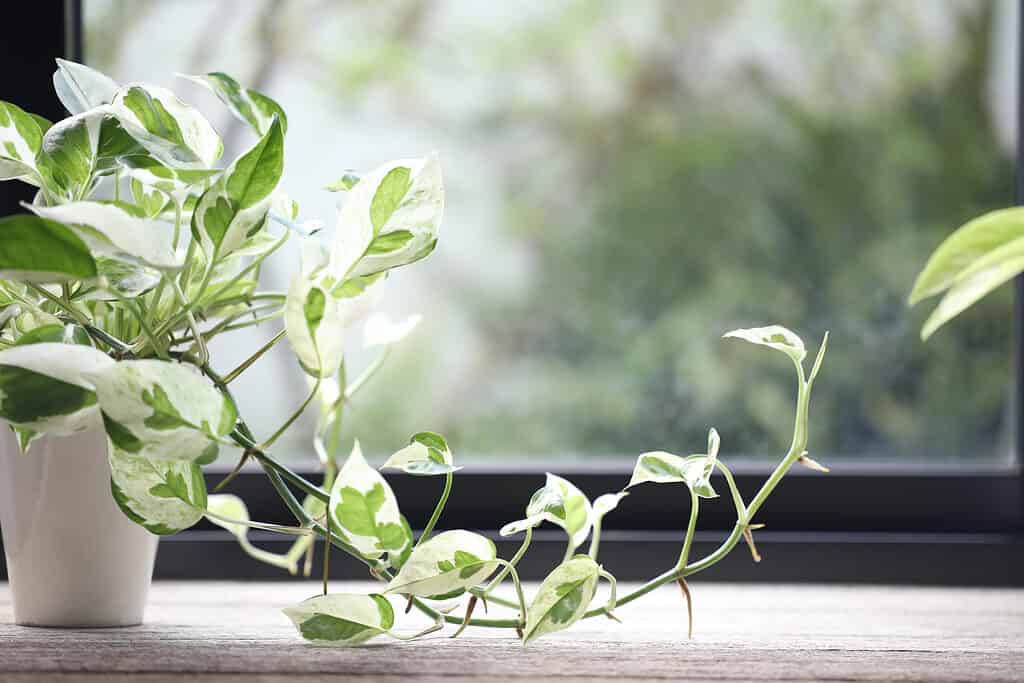
Pearls and jade pothos plants are low-maintenance, tolerate infrequent watering, and can withstand drought.
©iStock.com/paladin13
Boasting unique variegation with heart-shaped leaves edged in white or cream, the pearls and jade pothos (Epipremnum aureum ‘Pearls and Jade’) has a lovely pearly appearance. The green parts of the leaves are darker than other pothos varieties. This vining plant can climb a trellis or trail over the edge of a pot. It thrives in bright, indirect sunlight and can tolerate low light, but direct sunlight will cause leaf scorch.
Houseplants That Look Amazing and Require Very Little Care: Philodendron
Philodendrons, part of the Araceae family, thrive in lush, tropical rainforests in the Americas. With over 700 diverse species, they come in many shapes and sizes. Some have vines, while others are shrubs or trees. Their leaves offer a range of colors, from vibrant greens to variegated patterns and striking reds. Philodendrons are popular indoor plants for their low-maintenance nature. They prefer bright, indirect sunlight, well-draining soil, and watering when the top inch is dry. Regular misting or using a humidifier boosts humidity and benefits the plant. Here are a few beautiful examples of philodendron houseplants.
4. Philodendron Pink Princess
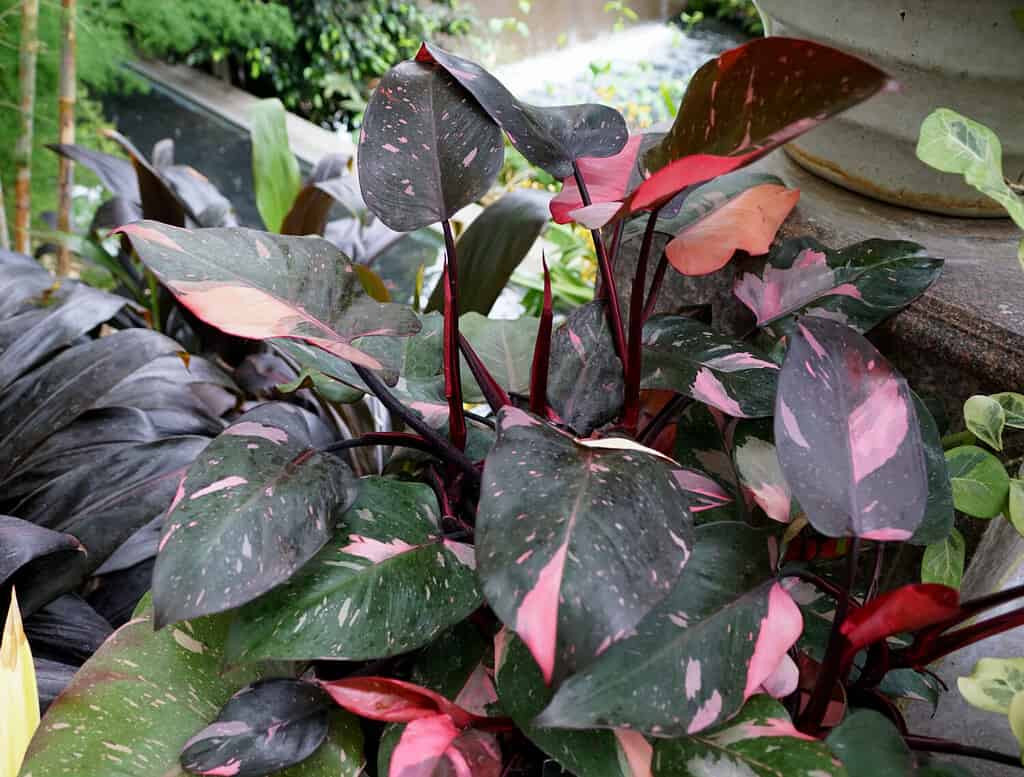
Proper care of your philodendron pink princess plant ensures years of companionship.
©Khairil Azhar Junos/Shutterstock.com
The philodendron pink princess (Philodendron erubescens ‘Pink Princess’) is a prized tropical plant known for its stunning pink and green leaves. Native to Colombia, it has heart-shaped leaves with a charming combination of green and pink variegation. The amount of pink can vary, with some plants having just a few pink leaves and others having predominantly pink foliage. The pink princess is a resilient plant that thrives in bright, indirect sunlight and well-draining soil. However, insufficient light can stunt leaf growth and fade the pink variegation.
5. Split-Leaf Philodendron
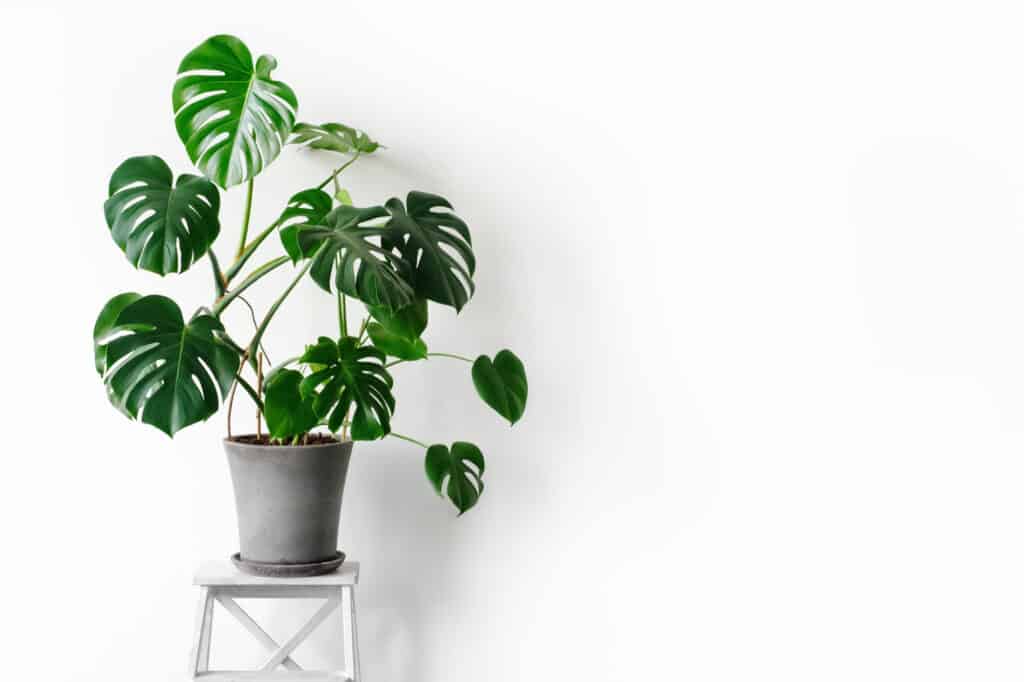
With uniquely splitting leaves, the
monstera deliciosais an extremely popular houseplant.
©Sozina Kseniia/Shutterstock.com
The split-leaf philodendron (Monstera deliciosa) is a popular houseplant with magnificent, perforated leaves. These large, glossy, heart-shaped leaves are green with white or yellow variegation. As the plant matures, its leaves develop holes and splits, earning its nickname, the “Swiss cheese plant”. The split-leaf philodendron is native to the lush rainforests of Mexico and Central America and can reach impressive heights of up to 20 feet. Indoors, however, it maintains a more compact size.
Houseplants That Look Amazing and Require Very Little Care: Calathea
Calathea, a genus of neotropical rhizomatous herbaceous perennials, boasts captivating foliage adorned with distinctive leaf patterns. These exotic plants are generally considered pet-friendly, making them a perfect choice for those who share their living space with curious animals. Moreover, by introducing Calathea into shared areas, you can seamlessly blend the beauty of nature with communal connections. Here are a few examples.
6. Peacock Plant
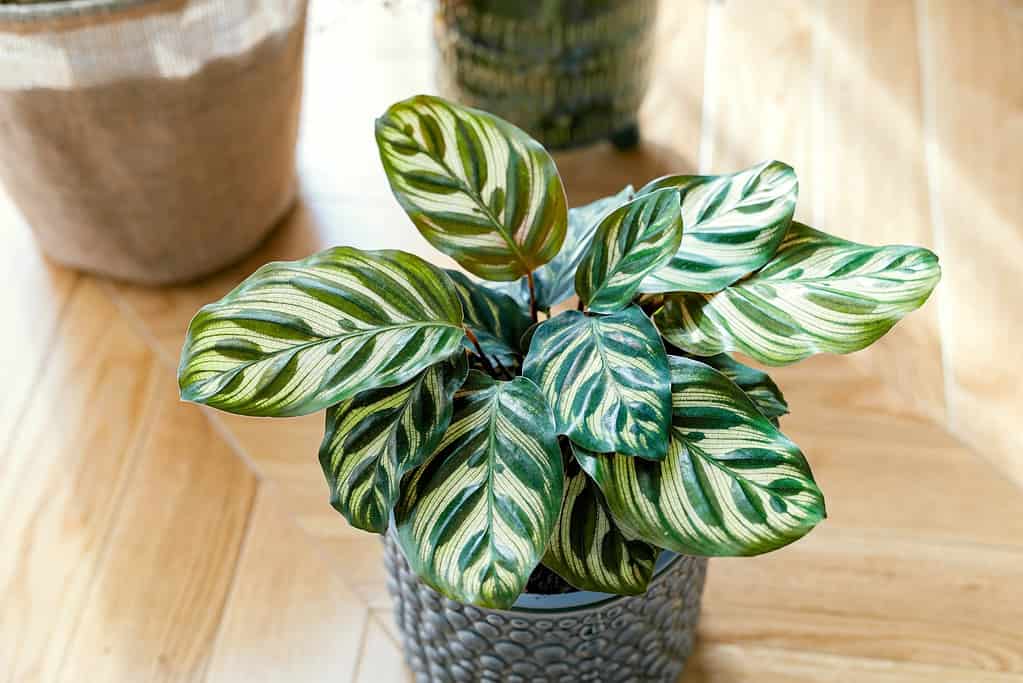
is resilient and can adapt to various conditions.
©Damian Lugowski/iStock via Getty Images
The Calathea makoyana, also known as the peacock plant, is a stunning and low-maintenance indoor plant loved for its captivating foliage. Its oval-shaped leaves feature striking dark green, cream, and pink stripes. Additionally, these leaves fold up during the night, earning it the nickname “prayer plant.” Interestingly, this plant can endure infrequent watering and drought periods, but it thrives when the soil is consistently moist.
7. Pinstripe Plant

has broad leaves with straight lines leading to the leaf margins.
©wahid hasyim asyari/iStock via Getty Images
Also called the pinstripe plant, Calathea ornata is a tropical houseplant with exquisite foliage. The oval-shaped leaves exhibit a captivating display of creamy white or pink stripes against a dark green backdrop. While Calathea ornata is relatively easy to care for, this popular houseplant can be sensitive to environmental changes. Additionally, Calathea ornata thrives in high humidity, necessitating regular leaf misting or placement in a humid environment like a bathroom.
8. Rose Painted Calathea

Calathea roseopicta is susceptible to fluoride, so it is advisable to employ filtered or bottled water for watering purposes.
©Francisco Herrera/iStock via Getty Images
Commonly known as the prayer plant or rose painted calathea, Calathea roseopicta is a captivating and sought-after houseplant renowned for its vibrant foliage. The leaves exude an oval shape with a deep green base and with delicate pink or rose-colored edges. It does best in bright, indirect sunlight and thrives in environments with high humidity levels.
Houseplants That Look Amazing and Require Very Little Care: Hoya
This remarkable genus is renowned for its glossy leaves and delightful, fragrant flowers. Thriving in bright, indirect light with regular watering, hoyas enchant with their tropical beauty. Hoyas have a distinctive climbing and vining nature, with thick, succulent-like leaves that set them apart from other vining plants. Additionally, these beautiful plants have stunning star-shaped flowers. Despite their slow growth rate, the anticipation of their development is truly rewarding. Here are some of the beloved Hoya houseplants.
9. Hoya Carnosa Krimson Queen

For optimal nourishment, a balanced fertilizer can be applied once a month during the spring and summer months.
©Nash 9owrrah/Shutterstock.com
Hoya carnosa ‘Krimson Queen’, a popular variety of Hoya carnosa or wax plant, has stunning variegated leaves in white or cream. The leaves, with their thick, waxy texture, exhibit a charming heart-shaped or oval form. This relatively low-maintenance plant thrives in both indoor and outdoor settings, provided the climate is warm. Bright, indirect sunlight and well-draining soil with sufficient moisture are best for optimal growth. Hoya carnosa Krimson Queen also blossoms with clusters of small, fragrant, star-shaped flowers in white or pink.
10. Hoya Australis

is a vining plant that can reach lengths of up to 6 feet.
©Khairil Azhar Junos/Shutterstock.com
Commonly referred to as the waxvine or common waxflower, Hoya australis is an Australian species of Hoya. Its leaves are oval-shaped and possess a waxy texture, typically displaying a vibrant green hue, although some variegated variations have white or cream tones. Clustered together, the petite white flowers of Hoya australis bloom during the spring and summer. This relatively low-maintenance plant thrives as a houseplant, favoring bright, indirect sunlight and well-draining, moist soil.
Houseplants That Look Amazing and Require Very Little Care: Snake Plants
Snake plants are exceptionally low-maintenance and can thrive in various environmental conditions. They do great in low-light conditions and require minimal watering. By absorbing harmful chemicals like formaldehyde, benzene, and trichloroethylene, snake plants also actively purify the air, reduce indoor dust, and release oxygen at night. Here are a few of the most popular snake plants for indoor home decor.
11. Sansevieria Cylindrica
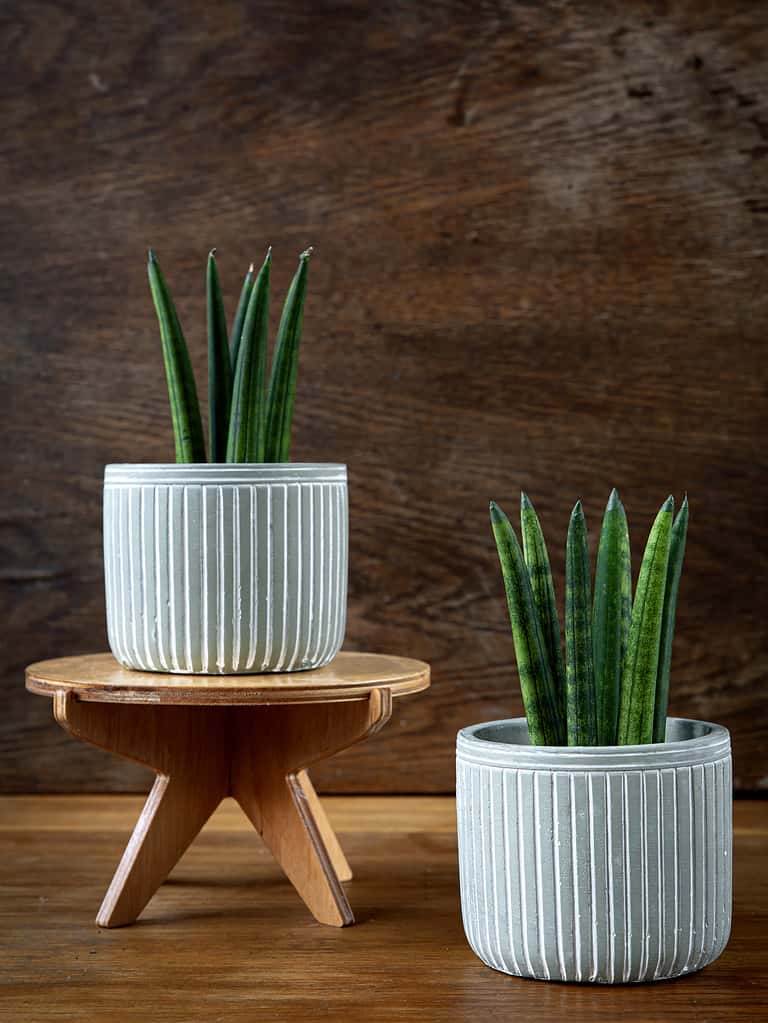
is an easy-care plant, drought-tolerant, and capable of thriving in low-light conditions.
©Damian Lugowski/iStock via Getty Images
Commonly known as the cylindrical snake plant or African spear, Sansevieria cylindrical is a succulent native to Angola. This slow-growing plant can reach heights of up to 3 feet with upright, cylindrical leaves. They have a smooth, glossy surface and are typically dark green, although variegated options with white or yellow markings are available.
12. Sansevieria Masoniana
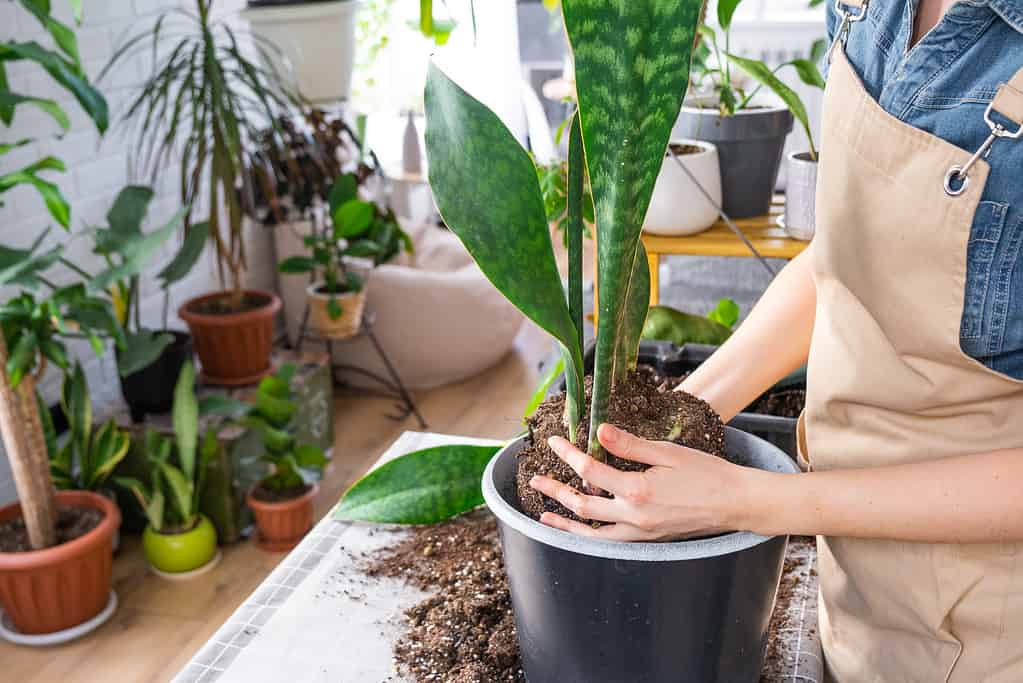
plants grow slowly, reaching up to 3 feet in height.
©Ольга Симонова/iStock via Getty Images
Native to the Democratic Republic of the Congo, Sansevieria masoniana is also known as the Mason’s Congo snake plant or whale fin snake plant. Its leaves are broad and paddle-shaped, boasting a sleek and glossy surface. Typically, they exhibit dark green hues with yellow or cream stripes. Sansevieria masoniana is an ideal choice for plant enthusiasts seeking a low-maintenance option. It thrives in drought-like conditions and tolerates low-light environments, suiting both novice plant caretakers and those with limited time to invest.
13. Sansevieria Trifasciata ‘Hahnii’

Bird’s nest succulents grow golden-green leaves that open into a beautiful rosette that resembles a bird’s nest.
©Bilalstock/Shutterstock.com
Sansevieria trifasciata ‘Hahnii’, commonly known as the bird’s nest snake plant, is a succulent species indigenous to Southeast Asia. This slow-growing plant can reach a height of up to 12 inches. Its leaves possess a smooth, glossy surface, typically exhibiting dark green hues with yellow or cream stripes. Sansevieria trifasciata ‘Hahnii’ is relatively low-maintenance, thriving in conditions of low light and offering drought tolerance.
Houseplants That Look Amazing and Require Very Little Care: Succulents
Succulents are renowned for their water storage abilities and can thrive in arid environments. Popular in dry climates, succulents are a visually appealing and wondrous addition to any home or garden. To care for them, provide bright sunlight, avoid overexposure, ensure well-draining soil, and water only when the soil is completely dry. These low-maintenance plants are perfect for gardening enthusiasts! Here are some popular types of succulents.
14. Aloe Vera

You can actually break open an aloe vera leaf and apply the gel directly to your skin!
©iStock.com/klenova
Aloe vera (Aloe barbadensis) is a popular succulent plant with medicinal properties. Native to the Arabian Peninsula, it can grow up to 2 feet tall with green, fleshy leaves. These unique leaves are filled with aloe vera gel, which is commonly used to heal cuts and burns on the skin. It’s also relatively easy to care for. It needs bright, indirect light and infrequent watering.
15. Echeveria
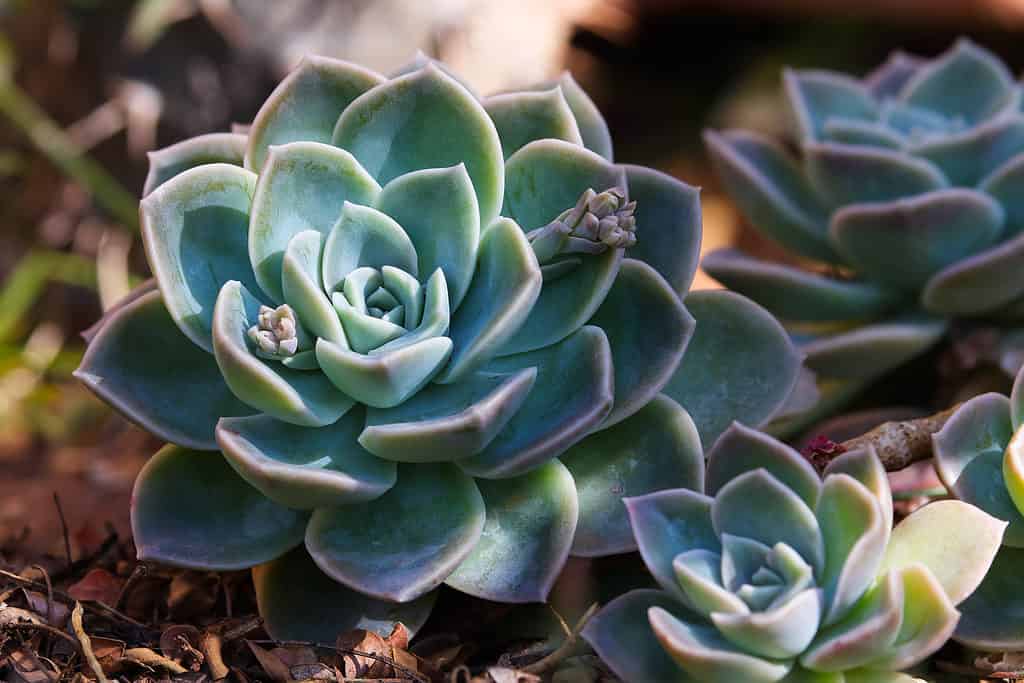
Echeveria succulents are native to Mexico and Central America.
©iStock.com/JJ van Ginkel
With over 1,500 species with diverse shapes, sizes, and colors, Echeveria succulents offer many beautiful choices. Their fleshy leaves are arranged in charming rosettes, boasting hues of green, blue, red, or purple, often with a delicate waxy coating. Renowned as popular houseplants, their allure lies not only in their beauty but also in their relative ease of care.
16. Haworthia

Native to southern
Africa
, Haworthia succulents thrive in dry sunny conditions.
©iStock.com/Mirjana Mutic
Haworthia, a genus of succulent plants native to South Africa, encompasses more than 100 diverse species varying in shape and size. Some boast glossy leaves, while others display spines or bumps. These low-maintenance plants are ideal for indoor cultivation, thriving in bright, indirect sunlight and well-draining soil. You only need to water them when the soil is dry to the touch.
17. Kalanchoe
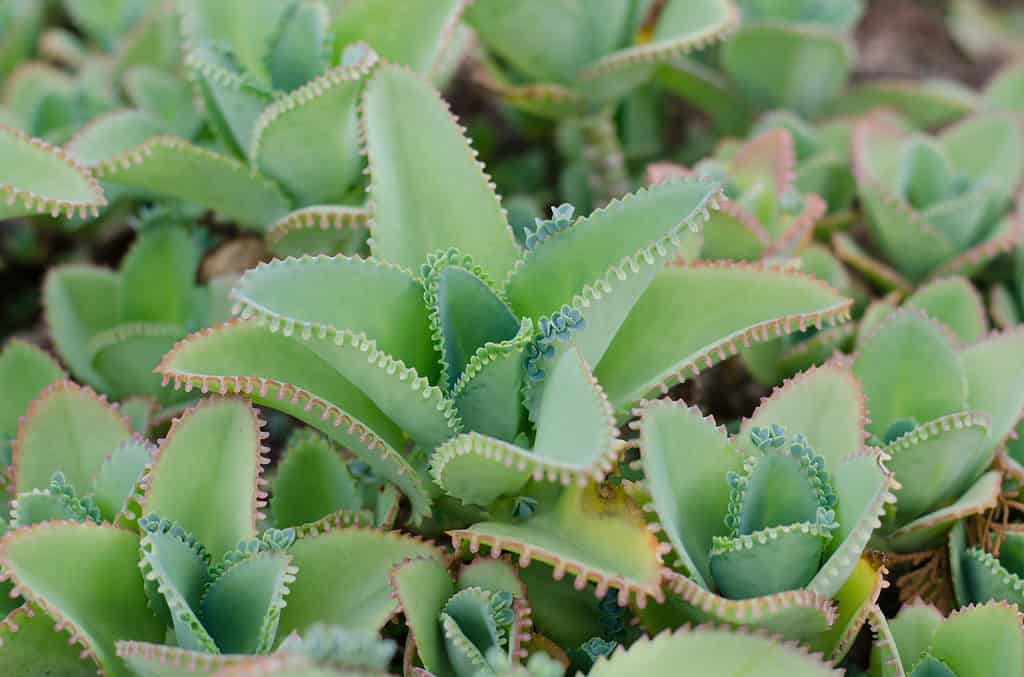
With more than 125 species of
kalanchoe
, you can choose between yellow, orange, red, purple, or pink plants.
©iStock.com/joloei
Kalanchoe, native to Madagascar, is a fascinating genus of succulent plants with over 125 species. Certain Kalanchoe varieties boast vibrant flowers, while others captivate with their exquisite foliage. These plants require minimal effort for their upkeep, making them excellent choices as houseplants. Ideally, they thrive in bright, indirect sunlight and well-draining soil.
Houseplants That Look Amazing and Require Very Little Care: Spider Plants
Spider plants, scientifically known as Chlorophytum comosum, are highly acclaimed for their exceptional air-purifying capabilities. Not only do they effectively remove harmful toxins from the air, but they also produce miniature plantlets. These plantlets can be easily propagated, allowing plant enthusiasts to effortlessly expand their collection of spider plants! Here are a few popular houseplant spider plants.
18. Bonnie Spider Plant

The Bonnie spider plant is low-maintenance and acts as an excellent air purifier, effectively removing toxins from the air.
©Navaashay rawat/iStock via Getty Images
The Bonnie spider plant (Chlorophytum Comosum ‘Bonnie’) is a variety of spider plant that is known for its wavy or curly leaves. Bonnie spider plants can grow to be about 12 to 18 inches tall and wide. The leaves are long and narrow, with a wavy or curly edge. They are typically green, but there are also variegated varieties with yellow or white markings. The Bonnie spider plant blooms in the spring and summer, producing small white flowers. The flowers are followed by small plantlets, which can be removed and propagated to grow new plants.
19. Hawaiian Spider Plant

The Hawaiian spider plant is highly sought after for indoor cultivation due to its relatively effortless care requirements.
©Irra/Shutterstock.com
The Hawaiian spider plant (Chlorophytum comosum ‘Hawaiian’) is a remarkable variety of spider plant known for its vibrant green leaves with a captivating yellow or white stripe through the center. Native to Hawaii, it thrives in similar climatic conditions across the globe. During the spring and summer seasons, the Hawaiian spider plant blossoms, revealing dainty, ivory-colored flowers. As the flowers wane, they give way to petite plantlets, which can be delicately detached and nurtured into new thriving plants.
20. Variegated Spider Plant

The variegated spider plant is tolerant of low light and can be grown outdoors in temperate climates.
©Coplay/Shutterstock.com
The variegated spider plant (Chlorophytum comosum ‘Vittatum’), also known as the airplane plant or reverse spider plant, is known for its green leaves with a wide, creamy white stripe down the center. Its arching leaves also make it a great choice for hanging baskets. It produces offsets or “babies” that can easily be propagated to create new plants.
Summary of Houseplants That Look Amazing and Require Very Little Care
| Scientific Name | Common Names | |
|---|---|---|
| 1. | Epipremnum aureum | Golden pothos |
| 2. | Epipremnum aureum ‘Marble Queen’ | Marble queen pothos |
| 3. | Epipremnum aureum ‘Pearls and Jade’ | Pearls and jade pothos |
| 4. | Philodendron erubescens ‘Pink Princess’ | Philodendron pink princess |
| 5. | Monstera deliciosa | Split-leaf philodendron |
| 6. | Calathea makoyana | Peacock plant |
| 7. | Calathea ornata | Pinstripe plant |
| 8. | Calathea roseopicta | Prayer plant or rose painted calathea |
| 9. | Hoya carnosa ‘Krimson Queen’ | Krimson Queen hoya |
| 10. | Hoya australis | Waxvine or common waxflower |
| 11. | Sansevieria Cylindrica | Snake plant cylindrica |
| 12. | Sansevieria Masoniana | Mason’s Congo snake plant |
| 13. | Sansevieria Trifasciata ‘Hahnii’ | Bird’s nest snake plant |
| 14. | Aloe barbadensis | Aloe Vera |
| 15. | Echeveria | Echeveria succulents |
| 16. | Haworthia | Haworthia succulents |
| 17. | Kalanchoe | Kalanchoe succulents |
| 18. | Chlorophytum Comosum ‘Bonnie’ | Bonnie spider plant |
| 19. | Chlorophytum Comosum ‘Hawaiian’ | Hawaiian spider plant |
| 20. | Chlorophytum Comosum ‘Vittatum’ | Variegated spider plant |
The photo featured at the top of this post is © A-Z-Animals.com/
Thank you for reading! Have some feedback for us? Contact the AZ Animals editorial team.







